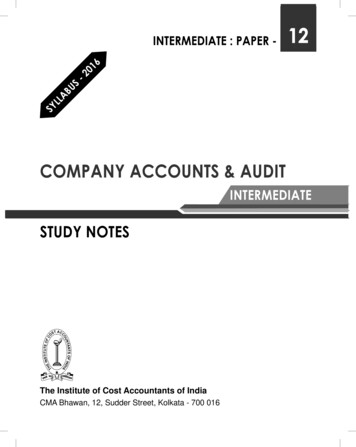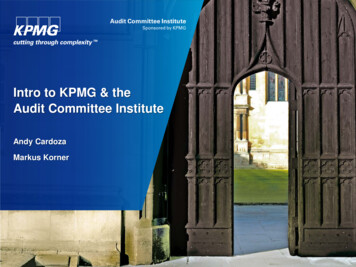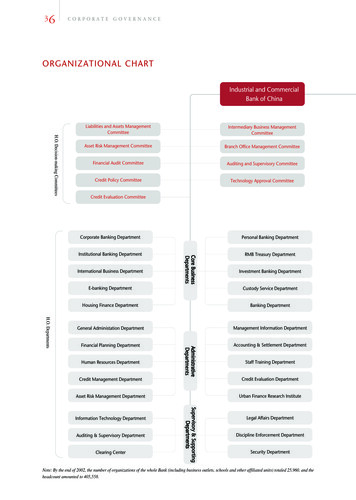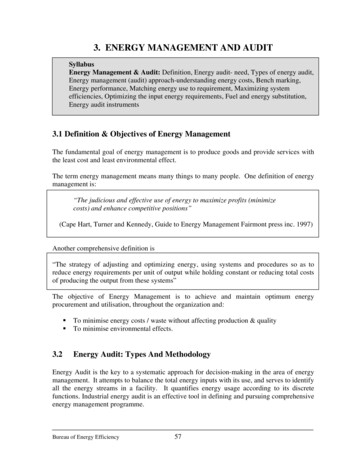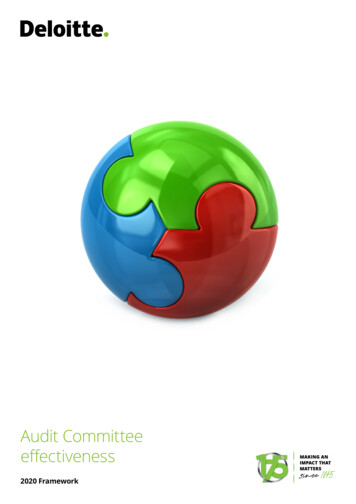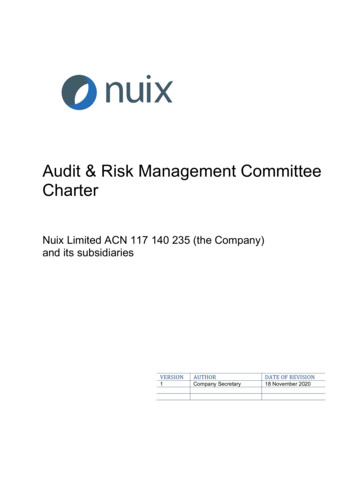
Transcription
Audit & Risk Management CommitteeCharterNuix Limited ACN 117 140 235 (the Company)and its subsidiariesVERSION1AUTHORCompany SecretaryDATE OF REVISION18 November 2020
1.INTRODUCTION1.1Purpose of CharterThis is the Charter of the Audit & Risk Management Committee established by the Board ofthe Company (the Charter). The Charter governs the operations of the Audit & RiskManagement Committee. It sets out the Committee's role and responsibilities, composition,structure and membership requirements.1.2Purpose of CommitteeThe Committee has been established to assist the board of the Company (Board) in fulfillingits corporate governance and oversight responsibilities in relation to the Company's financialreports and financial reporting process and internal control structure, risk managementsystems (financial and non-financial) and the external statutory audit process. Accordingly theCommittee will meet on a regular basis to:(a)review and approve internal audit and external statutory audit plans;(b)update the internal and external statutory audit plans;(c)review and approve financial reports;(d)review reports arising from any risk assurance activities;(e)assess the independence and performance of, and recommend the appointment orremoval of, external auditors or an internal head of audit;(f)review the adequacy of the Company's corporate reporting processes and internalcontrol and risk framework; and(g)review the effectiveness of the Company's compliance and risk managementfunctions.2.MEMBERSHIP2.1Composition of committeeThe Committee will:(a)comprise only of members of the Board of Directors (Directors) and members willbe appointed and removed by the Board;(b)be of sufficient size, independence and technical expertise to discharge its mandateeffectively;(c)consist of:(i)at least three members;(ii)only non-executive directors;(iii)a majority of independent 1 directors (Independent Directors); andRefer to the meaning of independent as discussed in the Corporate Governance Principles and Recommendations(4th edition) of the ASX Corporate Governance Council and outlined in Schedule 1.11
(iv)2.2an independent 2 Chair, who will be nominated by the Board from time totime, but who will not be the Chair of the Board;(d)comprise members who are financially literate (as in, members who are able to readand understand financial statements); and(e)include at least one member who has accounting and/or related financialmanagement expertise (as in, a member who is a qualified accountant or otherfinancial professional with experience of financial and accounting matters) andsome members who have an understanding of the industries in which the Companyoperates.Ceasing to be a member of the committeeA person will cease to be a member of the Committee if:2.3(a)the person gives reasonable notice in writing to the Committee Chair of the person'sresignation as a member of the Committee;(b)the Committee Chair gives the person notice in writing that the person is to cease tobe a member of the Committee; or(c)the person ceases to be a Director, in which case the person automatically ceasesto be a member of the Committee.Secretary(a)The Committee will have a secretary, which is to be the Company Secretary or suchother person as nominated by the Board (Committee Secretary).(b)The Committee Secretary will attend all Committee meetings.(c)The Committee Secretary, in conjunction with the Chair of the Committee, mustprepare an agenda to be circulated to each Committee member at least 2 fullworking days prior to each meeting of the Committee.(d)The Committee Secretary will distribute a meeting timetable for each forthcomingcalendar year.3.MEETINGS & AUTHORITY OF COMMITTEE3.1Meetings2(a)The Committee will meet often enough to undertake its role effectively, being atleast four times each calendar year.(b)The Committee will meet in private session at least annually to assessmanagement's effectiveness.(c)The quorum for any meeting will be 2 members.(d)Special meetings may be convened as required. The Chair will call a meeting ofthe Committee if requested to do so by any member of the Committee, by theexternal statutory auditors or by the Chair of the Board.See note 12
3.2(e)The Committee may invite such other persons (for example, staff, ManagingDirector/CEO, CFO, external parties) to its meetings, as it deems necessary,whether on a permanent or ad hoc basis.(f)The proceedings of all meetings will be minuted and these will be included in thepapers for the next Board meeting after each Committee meeting.AuthorityThe Board authorises the Committee, within the scope of its responsibilities, to:(a)investigate any matter brought to its attention with full access to all books, recordsand facilities;(b)seek any information it requires from an employee (and all employees are directedto co-operate with any request made by the Committee) or external parties;(c)obtain outside accounting, legal, insurance, compliance, risk management or otherprofessional advice as it determines necessary to carry out its duties;(d)interview management and internal and external auditors (with or withoutmanagement present);(e)ensure the attendance of Company officers at meetings as it thinks appropriate;and(f)from time to time, where circumstances dictate, operate outside of the current riskappetite set by the Board, provided that any such matters are brought to theattention of the Board.4.DUTIES AND RESPONSIBILITIES4.1Understanding the Company's BusinessThe Committee will ensure it understands the Company's structure, business and controls toensure that it can adequately assess the significant risks faced by the Company.4.2Corporate ReportingThe Committee's primary corporate reporting responsibility is to oversee the Company'scorporate reporting process on behalf of the Board and to report the results of its activities tothe Board. The Committee will:(a)review and make recommendations to the Board regarding the adequacy of theCompany's corporate reporting processes and internal control framework;(b)review the Company's financial statements to determine whether they reflect theunderstanding of the Committee of, and otherwise provide a true and fair view of,the financial position and performance of the Company and other group entities andmake any necessary recommendations to the Board;(c)review significant accounting policies adopted by the Company to ensurecompliance with AIFRS and generally accepted accounting principles;(d)review and make recommendations to the Board regarding the appropriateness ofthe accounting judgements or choices exercised by management in preparing theCompany's financial statements;(e)ensure that before the Board approves the Company's financial statements for afinancial period, that the Board and the Committee first receive from the CEO and3
the CFO a declaration that, in their opinion, the financial records of the Companyand its controlled entities have been properly maintained and that the financialstatements comply with the applicable accounting standards and give a true andfair view of the financial position and performance of the Company and itscontrolled entities and that the opinion has been formed on the basis of a soundsystem of risk management and internal control which is operating effectively;4.34.4(f)consider financial matters relevant to half yearly reporting in a timely manner; and(g)review other financial information distributed externally as required.Oversight of risk management framework(a)The Committee's primary risk management responsibility is to monitor and reviewthe Company's risk management framework at least annually to assess whether itis sound and is operating in accordance with the nature and extent of theacceptable levels of risk determined by the Board and report to the Board on theresults of those assessments.(b)The Committee will:(i)monitor the adequacy of the Company's processes for managing risk,including management's performance against the Company's riskmanagement framework and whether management is operating with dueregard to the risk appetite set by the Board, and whether the Company isadequately addressing financial and non-financial risk and contemporaryand emerging risks such as conduct risk 3, digital disruption, cybersecurity, privacy and data breaches, sustainability and climate change;(ii)make recommendations to the Board regarding changes that could bemade to the Company's processes for managing risk or to the riskappetite set by the Board;(iii)receive reports from internal audit on its reviews of the adequacy of theCompany's processes for managing risks;(iv)review any material incident involving fraud, break-downs of theCompany's risk controls or other failure of the Company's internalcontrols, and the relevant "lessons learned";(v)receive reports from management on new and emerging sources of riskand the risk controls that management has put in place to deal withthose risks; and(vi)oversee the Company's insurance program, having regard to thebusiness of the Company and its controlled entities and the insurablerisks associated with the business.Reporting to the Board(a)The Committee will regularly report to the Board on all matters relevant to theCommittee's role and responsibilities.As stated in the report of APRA’s Prudential Inquiry into the Commonwealth Bank of Australia (1 May 2018) at page7: “Conduct risk is ‘the risk of inappropriate, unethical or unlawful behaviour on the part of an organisation’smanagement or employees.’ At its simplest, conduct risk management goes beyond what is strictly allowed under lawand regulation (‘can we do it?’) to consider whether an action is appropriate or ethical (‘should we do it?’).”; Also referto Australian Securities and Investments Commission, Market Supervision Update Issue 57 – Conduct Risk, March2015.34
4.5(b)The Chair will report and as appropriate make recommendations to the Board aftereach meeting of the Committee on matters dealt with by the Committee.(c)As and when appropriate, the Committee will seek direction and guidance from theBoard on audit, risk management and compliance matters.(d)The Committee will ensure that the Board is made aware of audit, financialreporting, internal control, risk management and compliance matters which maysignificantly impact upon the Company in a timely manner.Assessment of accounting, financial and internal controlsPeriodically, the Committee will meet separately with management, the internal auditors andthe external statutory auditors to discuss:(a)the adequacy and effectiveness of the accounting and financial controls includingbut not limited to the Company's policies and procedures to assess, monitor, andmanage business risk and legal and ethical compliance programs;(b)the appropriateness of the accounting judgements and choices exercised bymanagement in preparing the Company's financial statements; and(c)issues and concerns warranting Committee attention, including but not limited totheir assessments of the effectiveness of internal controls and the process forimprovement.The Committee will provide sufficient opportunity for the internal auditors and the externalstatutory auditors to meet privately with the members of the Committee. The Committee willreview any audit problems or difficulties regarding management's response with the externalstatutory auditor.The Committee will receive regular reports from the external statutory auditor on the criticalpolicies and practices of the Company, and all alternative treatments of financial informationwithin generally accepted accounting principles that have been discussed with management.4.6Appointment of external statutory auditors and scope of externalstatutory auditThe Committee will:(a)make recommendations to the Board on the appointment, reappointment orreplacement, remuneration, monitoring of the effectiveness and independence ofthe external statutory auditors and resolution of disagreements betweenmanagement and the auditor regarding financial reporting 4;(b)consider review and make recommendations to the Board regarding the rotation ofthe audit engagement partner of the external statutory auditors;(c)review and make recommendations to the Board regarding fees payable to theexternal auditor for audit and non-audit services;(d)consider the scope and adequacy of the external statutory audit;When recommending the appointment of an auditor or assessing potential and continuing auditors, directors andmembers of the Audit & Risk Management Committee will have regard to best practices, including guidance outlinedin ASIC's paper on Audit quality: The role of directors and audit committees (ASIC Information Sheet 196)45
4.74.8(e)discuss with the external statutory auditors the overall scope of the externalstatutory audit, including identified risk areas and any additional agreed-uponprocedures;(f)make recommendations to the Board regarding any proposal for the externalauditor to provide non-audit services and whether this might compromise theirindependence;(g)make recommendations to the Board regarding disclosure (for example in itscorporate report, the governance disclosures in its annual report or on its website)of its process to verify the integrity of any periodic corporate report it releases to themarket that is not audited or reviewed by an external statutory auditor; and(h)ensure that the terms of appointment of the external auditors includes arequirement to attend (including via telephone or videoconference) the annualgeneral meeting (AGM) of the shareholders of the Company and that they areavailable at the AGM to answer any questions from shareholders relevant to theaudit.Pre-approval of audit and non-audit services provided by externalstatutory auditors(a)The Committee will pre-approve all audit and non-audit services provided by theexternal statutory auditors and will not engage the external statutory auditors toperform any non-audit/assurance services that may impair or appear to impair theexternal statutory auditor's judgement or independence in respect of the Company.(b)The Committee may delegate pre-approval authority to a member of theCommittee. The decisions of any Committee member to whom pre-approvalauthority is delegated must be presented to the full Committee at its next scheduledmeeting.Assessment of the external audit(a)The Committee, at least on an annual basis, will obtain and review a report by theexternal auditors describing (or meet, discuss and document the following withthem):(i)the audit firm's internal quality control procedures;(ii)any material issues raised by the most recent internal quality controlreview, or peer review, of the audit firm, or by any enquiry orinvestigation by governmental or professional authorities, within thepreceding five years, respecting one or more independent audits carriedout by the firm, and any steps taken to deal with any such issues; and(iii)all relationships between the external auditor and the Company (toassess the auditor's independence).6
(b)(c)4.9The Committee will set clear hiring policies for employees or former employees ofthe external auditor in order to prevent the impairment or perceived impairment ofthe external auditor's judgement or independence in respect of the Company. TheCommittee will review and assess the independence and performance of theexternal statutory auditor 5, including:(i)a review of any relationships with the Company or any other entity thatmay impair or appear to impair the external statutory auditor's judgementor independence in respect of the Company;(ii)a review of any appointments of the external statutory auditor to providenon-audit services and whether those appointments may impair orappear to impair the external statutory auditor's judgement orindependence in respect of the Company.The Committee will draft an annual statement for inclusion in the Company's annualreport as to whether the Committee is satisfied the provision of non-audit services iscompatible with external auditor independence.Assessment of the internal auditThe Committee will:(a)be responsible for the appointment and removal of the head of the internal auditfunction;(b)consider and discuss the scope and adequacy of the internal audit with the internalauditor, including the internal audit plan, work program and quality controlprocedures; and(c)consider the independence, objectivity and performance of the internal auditfunction.The internal audit function is a centralised function, to facilitate the assessment of risks byeach business unit and to report to the Committee on the material risks and actions beingundertaken by each business unit to mitigate these risks to an acceptable level.As part of its review, the Committee will review:4.10(d)the internal auditor's charter and resources to ensure no unjustified restrictions orlimitations are imposed upon internal audit staff and that resourcing is adequateand consider and discuss the scope and adequacy of the internal audit with theinternal auditor; and(e)consider whether the head of the internal audit is suitably qualified and has a directreporting line to the Committee to bring the requisite degree of skill, independenceand objectivity to the role.Compliance with Laws and RegulationsThe Committee will:(a)gain an understanding of the current areas of greatest compliance risk (financialand non-financial) and review these areas on a regular basis;When assessing the quality of audits, directors and members of the Audit & Risk Management Committee will haveregard to best practices, including guidance outlined in ASIC's paper on Audit quality: The role of directors and auditcommittees (ASIC Information Sheet 196).57
4.11(b)obtain regular updates from management, the Company's legal counsel, auditorsand any external parties as it thinks fit regarding audit, risk management andcompliance matters and regularly review existing compliance systems and considerany deficiencies in compliance risk measures;(c)review any legal matters which could significantly impact the Company'scompliance and risk management systems, and any significant compliance andreporting issues, including any recent internal regulatory compliance reviews andreports;(d)review the effectiveness of the compliance function at least annually, including thesystem for monitoring compliance with laws and regulations and the results ofmanagement's investigations and follow-ups (including disciplinary action) of anyfraudulent acts or non-compliance;(e)be satisfied that all regulatory compliance matters have been considered in thepreparation of the Company's official documents; and(f)review the findings of any examinations by regulatory agencies and oversee allliaison activities with regulators.Review of media releases, announcements and complaintsThe Committee will:4.12(a)regularly review the operation of the Company’s Continuous Disclosure Policy andCommunications Policy and discuss media releases, ASX announcements andassess any other information provided to analysts and whether any changes arerequired;(b)review the appropriateness of processes management has in place to ensure thatthe information and representations contained in all representation letters signed bymanagement to ensure that the information provided is complete and appropriate;(c)establish procedures for the receipt, retention, and treatment of complaints orincidents received by the Company regarding accounting, internal accountingcontrols, or auditing matters, and the confidential, anonymous submission byemployees of the Company of concerns regarding questionable accounting orauditing matters;(d)review corporate legal reports of evidence of a material violation of the CorporationsAct 2001 (Cth), the ASX Listing Rules or breaches of fiduciary duties; and(e)receive copies of any reports compiled by whistleblower protection officers inrespect of any whistleblowing complaints (in accordance with anonymity andconfidentiality requirements).Committee performance(a)The Committee will perform an evaluation of its performance at least once acalendar year to determine whether it is functioning effectively by reference tocurrent best practice.(b)The Board will evaluate the performance of the Committee as appropriate.5.OTHER MATTERS5.1Amendment of CharterThis Charter can only be amended with the approval of the Board.8
5.2Adoption of Charter and periodic reviewThis Charter was adopted by the Board on the date on the front cover of this Charter, andtakes effect from that date and replaces any previous charter in this regard.The Committee must review and reassess this Charter and the Risk Management Policy atleast once each reporting period and, on each occasion, obtain the approval of the Board toany amendments to the Charter or Risk Management Policy. The Board will also review thisCharter and the Risk Management Policy periodically. Such review should be undertaken toenable the Committee and the Board (as applicable) to satisfy itself that the Risk ManagementPolicy and this Charter continues to be sound and that the Company is operating with dueregard to the risk appetite set by the Board.The Company Secretary will communicate any amendments to employees as appropriate.9
Schedule 1 - Independence as defined by the ASX Corporate Governance Councilin their Corporate Governance Principles and Recommendations (4th edition)A director of a listed entity should only be characterised and described as an independent director if he orshe is free of any interest, position or relationship that might influence, or reasonably be perceived toinfluence, in a material respect their capacity to bring an independent judgement to bear on issues beforethe board and to act in the best interests of the entity as a whole rather than in the interests of anindividual security holder or other party.The ASX Corporate Governance Principles and Recommendations (4th edition) provide certain examplesfor assessing the independence of directors and outline relationships which may affect independentstatus. They provide that when determining the independent status of a director the board shouldconsider whether the director:1.is, or has been, employed in an executive capacity by the entity or any of its child entities andthere has not been a period of at least three years between ceasing such employment andserving on the board;2.receives performance-based remuneration (including options or performance rights) from, orparticipates in an employee incentive scheme of, the entity;3.is, or has been within the last three years, in a material business relationship (eg as a supplier,professional adviser, consultant or customer) with the entity or any of its child entities, or is anofficer of, or otherwise associated with, someone with such a relationship;4.is, represents, or is or has been within the last three years an officer or employee of, orprofessional adviser to, a substantial holder;5.has close personal ties with any person who falls within any of the categories described above;or6.has been a director of the entity for such a period that their independence from managementand substantial holders may have been compromised.Where a director falls within one or more of these examples, the board should rule the director not to beindependent unless it is clear that the interest, position or relationship in question is not material and willnot interfere with the director’s capacity to bring an independent judgement to bear on issues before theboard and to act in the best interests of the entity as a whole rather than in the interests of an individualsecurity holder or other party.10
Management Committee. It sets out the Committee's role and responsibilities, composition, structure and membership requirements. 1.2 Purpose of Committee The Committee has been established to assist the board of the Company (Board) in fulfilling its corporate governance and oversight responsibilities in relation to the Company's financial






